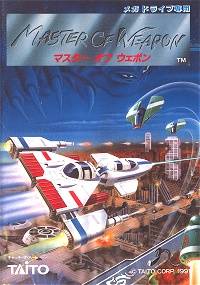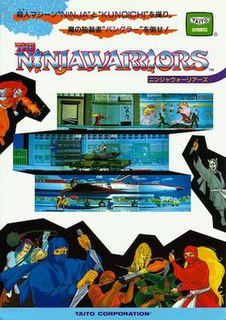 W
WArkanoid is a 1986 block breaker arcade game developed and published by Taito. In North America, it was published by Romstar. Controlling a paddle-like craft known as the Vaus, the player is tasked with clearing a formation of colorful blocks by deflecting a ball towards it without letting the ball leave the playfield. Some blocks contain power-ups that have various effects, such as increasing the length of the Vaus, creating several additional balls, or turning the Vaus into a laser cannon.
 W
WArkanoid - Revenge of Doh is an arcade game released by Taito Corporation in 1987 as a sequel to Arkanoid.
 W
WCameltry (キャメルトライ) is an arcade video game released in 1989 by Taito.
 W
WDarius is a 1987 horizontal-scrolling shooter arcade game developed and published by Taito. Players control a starship named the Silver Hawk in its mission to destroy the Belser empire before they wipe out the planet Darius. Its gameplay involves traversing through a series of scrolling levels while destroying enemies and collecting power-up icons. It is notable for its unique three-screen panoramic display.
 W
WDarius Gaiden is a 1994 horizontal-scrolling shooter arcade game developed and published by Taito. The fifth entry in its Darius series, players control a starship named the Silver Hawk in its mission to destroy the Belsar empire before it wipes out the population of planet Darius. Gaiden adds several new features to the core concepts of its predecessors, including screen-clearing black hole bombs and the ability to capture mid-level bosses. The game has been ported to several consoles, including the Sega Saturn and PlayStation.
 W
WDarius II is a 1989 arcade video game developed by Taito. It is the direct sequel to the 1987 Darius. It was later released as Sagaia in Japan in 1991 for the Game Boy as well as non-Japanese ports. A remake was released for the PC Engine Super CD-ROM² as Super Darius II in 1993.
 W
WDariusburst is a horizontal scrolling shooter developed by Pyramid and published by Taito. Forming part of the Darius series, it was released for the PlayStation Portable December 24, 2009. Like previous Darius games, Dariusburst is an offbeat sci-fi shooter set in outer space with aquatic-themed robotic enemies. In keeping with tradition, the game also features branching paths instead of the linear progression found in most video games. There are a total of 11 zones in the game, with 5 stages per run.
 W
WFootball Champ is an arcade-style football (soccer) video game. The game was produced by Team Dogyan developers in Japan, and originally released in the arcades by Taito Corporation in 1990.
 W
WG-Darius is a shoot'em up arcade game, released by Taito in 1997. It is the fourth arcade installment of the Darius series and the first in the series to feature three-dimensional polygonal graphics.
 W
WKiKi KaiKai is a shoot 'em up video game developed and published by Taito Corporation originally for Japanese arcades in 1986. Since then, the game has received a number of console and home computer ports in and outside Japan, both as a stand-alone title and as part of compilations. The game originally saw a limited release in North American and European arcades as Knight Boy, a bootleg copy of the original Japanese version not officially licensed by Taito.
 W
WThe Legend of Kage is a 1985 arcade game by Taito which was released for several contemporary video game home systems in the following years.
 W
WMaster of Weapon is a 1989 vertical-scrolling shooter arcade game developed and published by Taito in Japan. It was ported to the Sega Mega Drive in 1990.
 W
WNight Striker is a 1989 shoot 'em up video game developed and published by Taito for the Taito Z System. In the game, the player flies an armoured car shooting enemy invaders to destroy a terrorist organisation. Night Striker combines gameplay elements of Sega's Space Harrier and Out Run. Versions were released for the Sega Mega-CD in 1993, Sony PlayStation in 1995, and Sega Saturn in 1996. A version was released on the Taito Memories II Gekan compilation for the PlayStation 2 in 2007. Night Striker received mixed reviews, and the Mega-CD version in particular was heavily criticised, primarily due to poor graphics. The music was composed by Taito's Zuntata sound team, and has been released separately. The game was only released in Japan.
 W
WThe Ninja Warriors (ニンジャウォーリアーズ) is a side-scrolling beat 'em up developed and released by Taito in 1987. The original arcade game situated one display in between projected images of two other displays, creating the appearance of a triple-wide screen. Ports were released for the Amiga, Atari ST, ZX Spectrum, Commodore 64, Amstrad CPC, TurboGrafx-16, and Mega-CD.
 W
WOperation Thunderbolt is a shooting gallery video game made by Taito and released in arcades in 1988. It is the sequel to Operation Wolf. Like its predecessor, the game uses mounted positional guns as controllers. It also adds two-player simultaneous play. Versions of the game were released for Amiga, Commodore 64, and Super Nintendo. An arcade exclusive sequel was released in 1994: Operation Wolf 3.
 W
WRainbow Islands: The Story of Bubble Bobble 2 (レインボーアイランド) is a 1987 arcade game developed and published by Taito. The arcade version was licensed to Romstar for North American manufacturing and distribution. The game is subtitled "The Story of Bubble Bobble 2" and is the sequel to Taito's hit game Bubble Bobble from the previous year. It is the second of four arcade games in the Bubble Bobble series. The game was ported for numerous home computers and game consoles.
 W
WRastan Saga II (ラスタンサーガ2), known in Europe as Nastar and in North America as Nastar Warrior is a hack and slash platform arcade game developed and released by Taito in 1988. It is the sequel to Rastan.
 W
WShinseiki Odysselya (神聖紀オデッセリア) is a role-playing video game released by Vic Tokai in Japan for the Super Famicom in 1993. An American version was scheduled in 1994 titled Lost Mission, but was canceled. A quick review of the game was published in Vol. 58 of Nintendo Power with a scheduled release date of March 1994, which criticized the game for its "poor story translation" and "standard RPG play."
 W
WVolfied is an arcade game designed by Fukio Mitsuji and released by Taito in 1989. It is a successor to Qix, with extra features and a futuristic science fiction aesthetic, rather than Qix's abstract geometry style; the player pilots a small spaceship named "Monotros" instead of a Stix, and the enemies come in the form of various aliens.